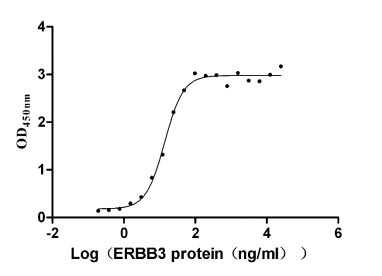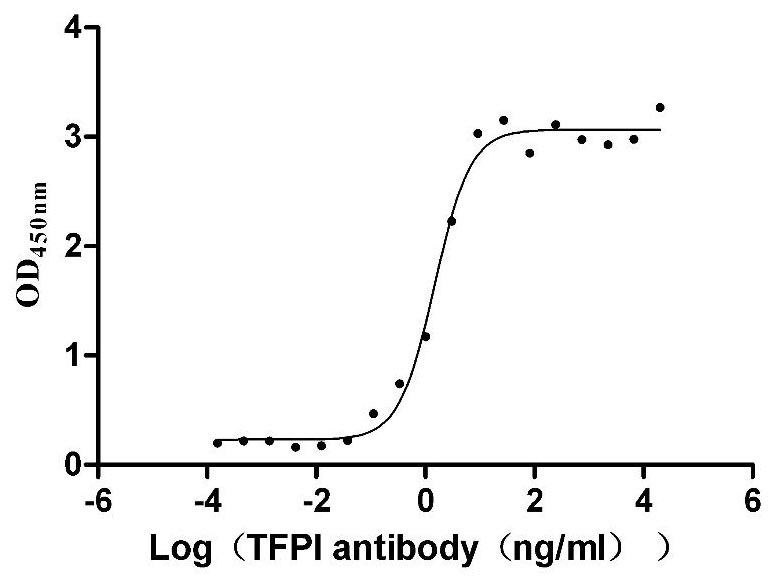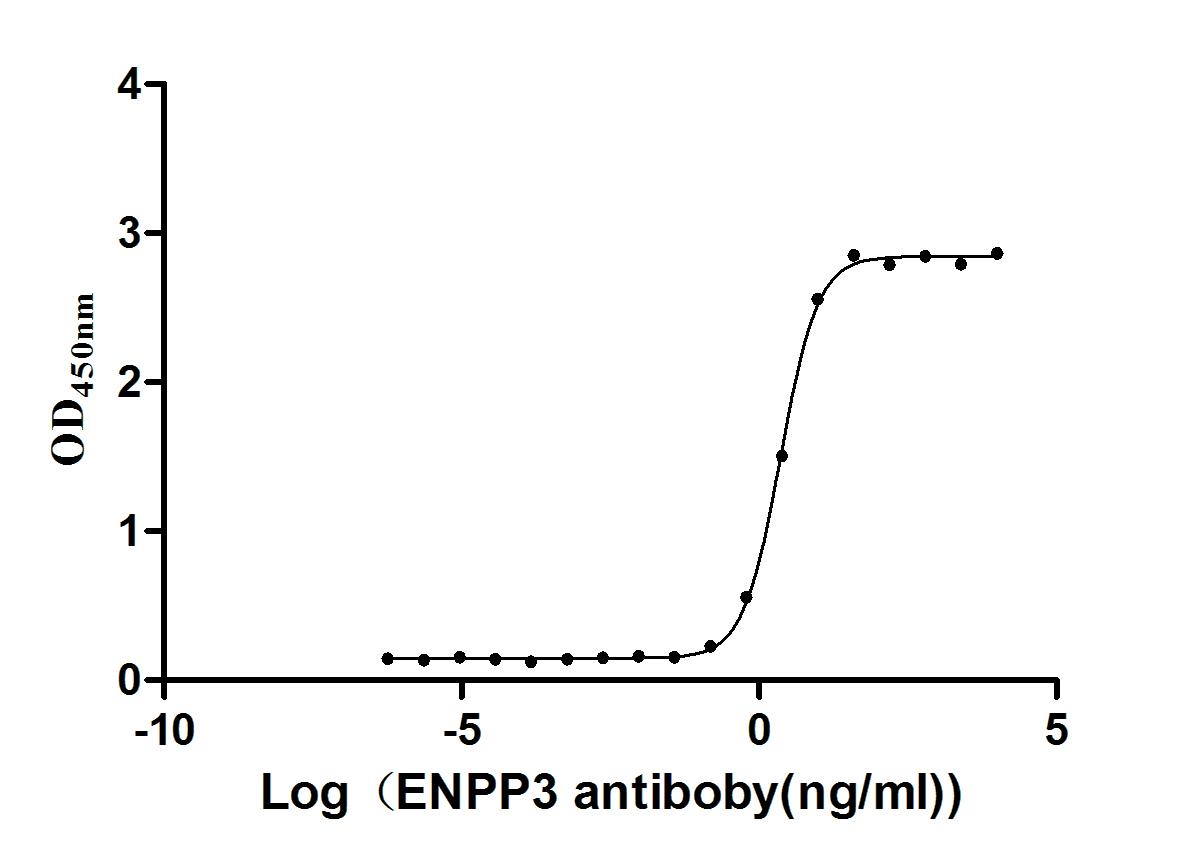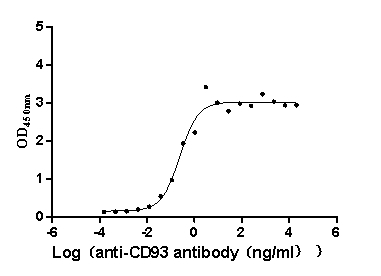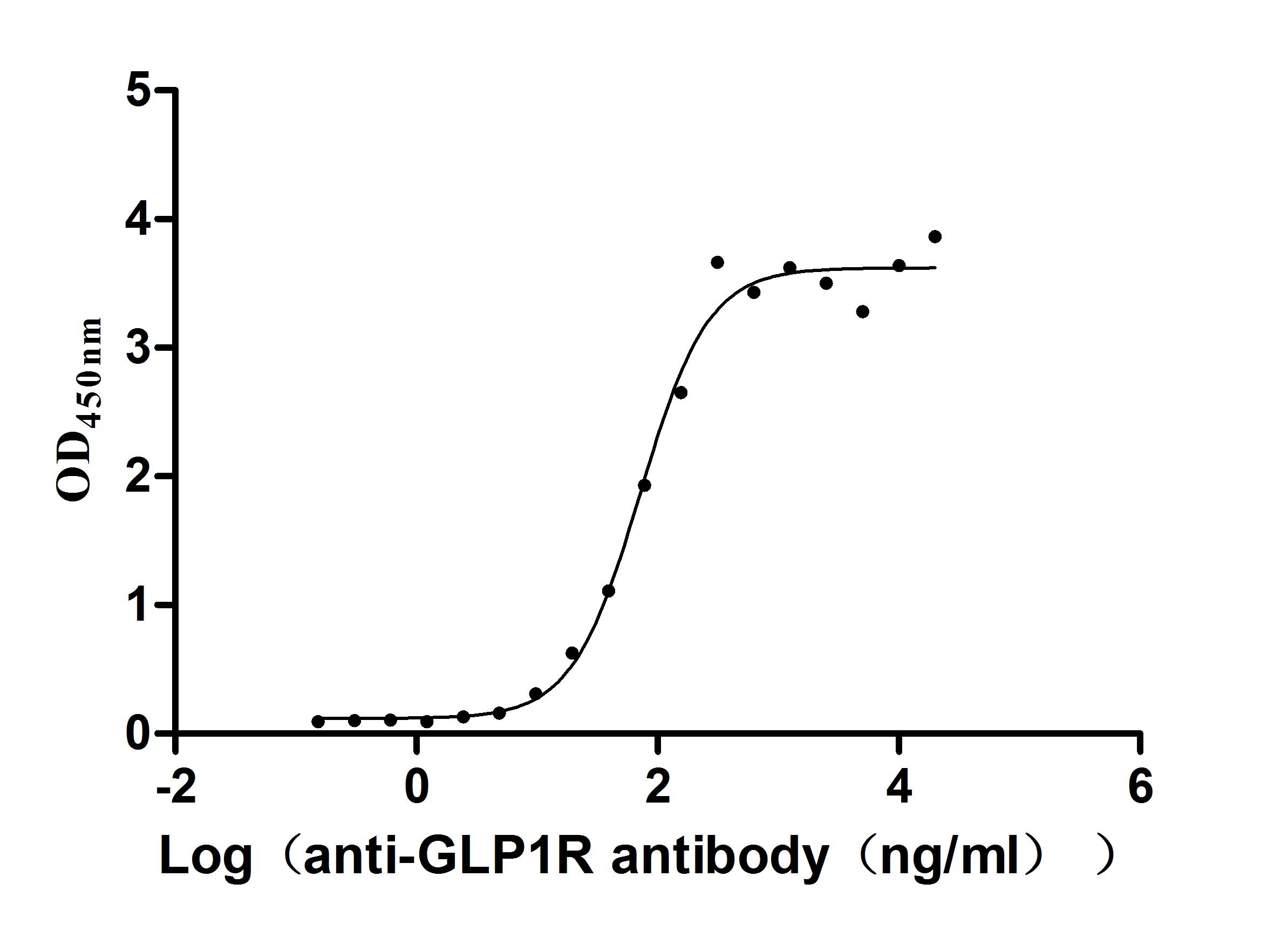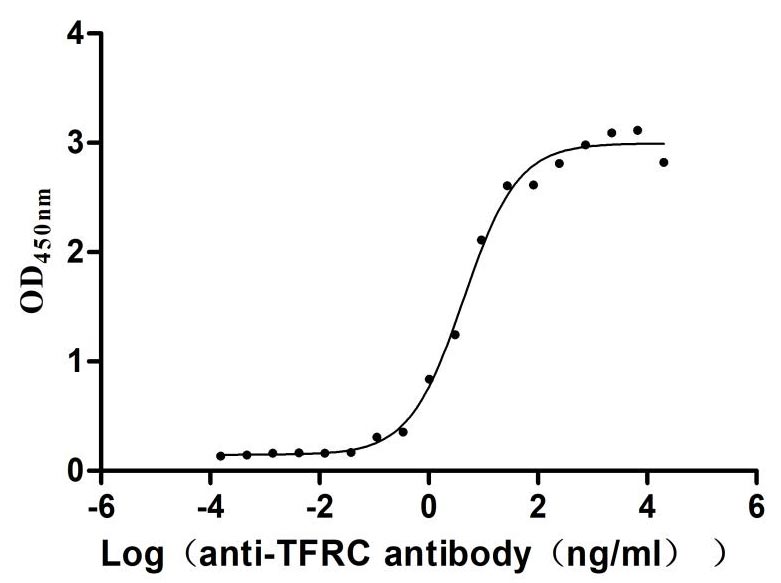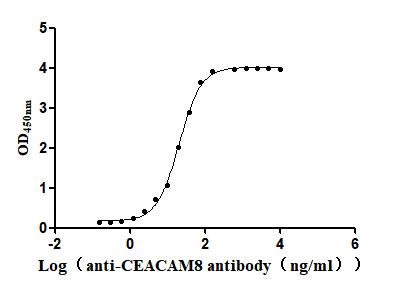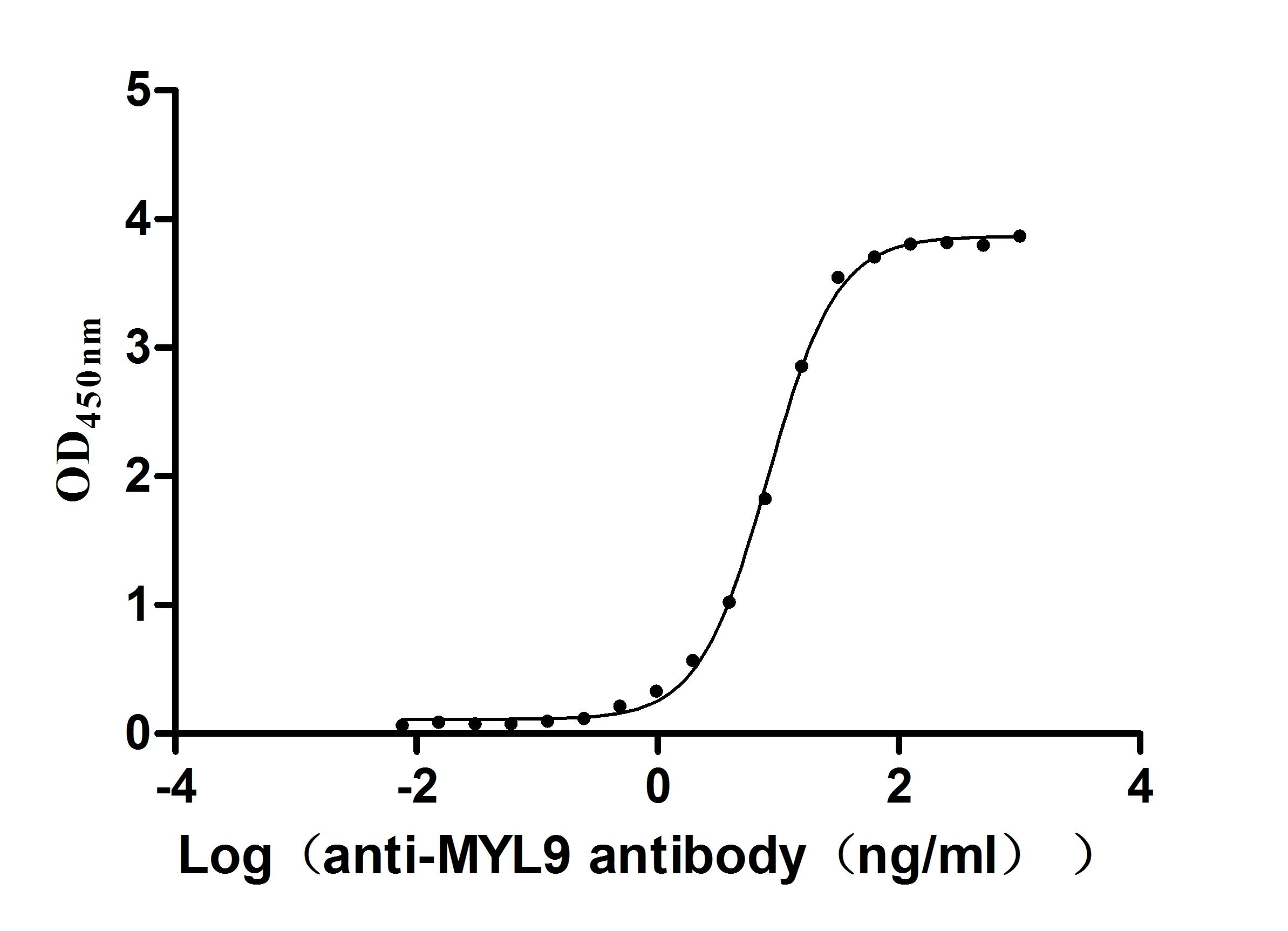Recombinant Escherichia coli Cell division protein FtsZ (ftsZ)
-
中文名称:大肠杆菌ftsZ重组蛋白
-
货号:CSB-YP364301ENV
-
规格:
-
来源:Yeast
-
其他:
-
中文名称:大肠杆菌ftsZ重组蛋白
-
货号:CSB-EP364301ENV
-
规格:
-
来源:E.coli
-
其他:
-
中文名称:大肠杆菌ftsZ重组蛋白
-
货号:CSB-EP364301ENV-B
-
规格:
-
来源:E.coli
-
共轭:Avi-tag Biotinylated
E. coli biotin ligase (BirA) is highly specific in covalently attaching biotin to the 15 amino acid AviTag peptide. This recombinant protein was biotinylated in vivo by AviTag-BirA technology, which method is BriA catalyzes amide linkage between the biotin and the specific lysine of the AviTag.
-
其他:
-
中文名称:大肠杆菌ftsZ重组蛋白
-
货号:CSB-BP364301ENV
-
规格:
-
来源:Baculovirus
-
其他:
-
中文名称:大肠杆菌ftsZ重组蛋白
-
货号:CSB-MP364301ENV
-
规格:
-
来源:Mammalian cell
-
其他:
产品详情
-
纯度:>85% (SDS-PAGE)
-
基因名:ftsZ
-
Uniprot No.:
-
别名:ftsZ; sfiB; sulB; b0095; JW0093Cell division protein FtsZ
-
种属:Escherichia coli (strain K12)
-
蛋白长度:full length protein
-
表达区域:1-383
-
氨基酸序列MFEPMELTND AVIKVIGVGG GGGNAVEHMV RERIEGVEFF AVNTDAQALR KTAVGQTIQI GSGITKGLGA GANPEVGRNA ADEDRDALRA ALEGADMVFI AAGMGGGTGT GAAPVVAEVA KDLGILTVAV VTKPFNFEGK KRMAFAEQGI TELSKHVDSL ITIPNDKLLK VLGRGISLLD AFGAANDVLK GAVQGIAELI TRPGLMNVDF ADVRTVMSEM GYAMMGSGVA SGEDRAEEAA EMAISSPLLE DIDLSGARGV LVNITAGFDL RLDEFETVGN TIRAFASDNA TVVIGTSLDP DMNDELRVTV VATGIGMDKR PEITLVTNKQ VQQPVMDRYQ QHGMAPLTQE QKPVAKVVND NAPQTAKEPD YLDIPAFLRK QAD
-
蛋白标签:Tag type will be determined during the manufacturing process.
The tag type will be determined during production process. If you have specified tag type, please tell us and we will develop the specified tag preferentially. -
产品提供形式:Lyophilized powder
Note: We will preferentially ship the format that we have in stock, however, if you have any special requirement for the format, please remark your requirement when placing the order, we will prepare according to your demand. -
复溶:We recommend that this vial be briefly centrifuged prior to opening to bring the contents to the bottom. Please reconstitute protein in deionized sterile water to a concentration of 0.1-1.0 mg/mL.We recommend to add 5-50% of glycerol (final concentration) and aliquot for long-term storage at -20℃/-80℃. Our default final concentration of glycerol is 50%. Customers could use it as reference.
-
储存条件:Store at -20°C/-80°C upon receipt, aliquoting is necessary for mutiple use. Avoid repeated freeze-thaw cycles.
-
保质期:The shelf life is related to many factors, storage state, buffer ingredients, storage temperature and the stability of the protein itself.
Generally, the shelf life of liquid form is 6 months at -20°C/-80°C. The shelf life of lyophilized form is 12 months at -20°C/-80°C. -
货期:Delivery time may differ from different purchasing way or location, please kindly consult your local distributors for specific delivery time.Note: All of our proteins are default shipped with normal blue ice packs, if you request to ship with dry ice, please communicate with us in advance and extra fees will be charged.
-
注意事项:Repeated freezing and thawing is not recommended. Store working aliquots at 4°C for up to one week.
-
Datasheet :Please contact us to get it.
靶点详情
-
功能:Essential cell division protein that forms a contractile ring structure (Z ring) at the future cell division site. The regulation of the ring assembly controls the timing and the location of cell division. One of the functions of the FtsZ ring is to recruit other cell division proteins to the septum to produce a new cell wall between the dividing cells. Binds GTP and shows GTPase activity. Polymerization and bundle formation is enhanced by CbeA.
-
基因功能参考文献:
- Efficient models of polymerization applied to FtsZ ring assembly in Escherichia coli. PMID: 29686085
- FtsZ E237 and E241 are critical amino acids that affect the amphipathic helix characteristics of FtsZ (236-245) domain, FtsZ assembly and FtsZ-FtsA interaction in E. coli strains. PMID: 29756735
- the presence of FtsN always correlated with membrane invagination, indicating that allosteric activation of peptidoglycan ingrowth is the trigger for constriction of the cell envelope during cell division in E. coli. PMID: 27609565
- Although several other protein modulators are known to target FtsZ, the CbtA-interacting surface we identify represents a novel inhibitory target. Our findings establish CbtA as a dual function toxin that inhibits both cell division and cell elongation via direct and independent interactions with FtsZ and MreB. PMID: 28931012
- MreB is not recruited to the FtsZ ring in secA mutant cells, contributing to division arrest and cell filamentation.. Thus, when we reroute RodZ, MreB membrane-anchor, by fusing it to a SecA-independent integral membrane protein and overproducing it, MreB localization is restored and the defect in cell division is corrected. PMID: 28945742
- FtsZ treadmilling provides a mechanism for achieving uniform septal cell wall synthesis to enable correct polar morphology. PMID: 28209899
- ZapD acts as a molecular cross-linking reagent between FtsZ protofilaments to enhance FtsZ assembly PMID: 28100778
- Residues R56, R221, and R225 of zapD are important for bundling FtsZ filaments. PMID: 27021560
- These results suggest that the in vivo organization of the Z-ring is largely dependent on the intrinsic polymerization properties of FtsZ, which are significantly influenced by the GTPase activity and concentration of FtsZ. PMID: 27310678
- FtsZ protein interaction domains and motifs with GP0.4 protein from bacteriophage T7 provide target sites for antibacterial drug design. PMID: 27411831
- Combined, these data reveal the molecular basis for the SlmA-DNA-FtsZ interaction with implications for SlmA's NO function and underscore the ability of the FtsZ CTD to adopt a wide range of conformations, explaining its ability to bind diverse regulatory proteins. PMID: 27091999
- E75, R78 and D82 of FtsZ are key residues for FtsZ self-assembly and FtsZ-MreB interaction. PMID: 27373074
- These data suggest that FtsZ, and potentially other enzymes whose assembly is similarly regulated, can compensate for defects in catalysis through increases in substrate binding and subunit-subunit interactions. PMID: 26463348
- ZapC binds the large FtsZ globular core rather than C-terminal tail, and the presence of two adjacent pockets suggests possible mechanisms for ZapC-mediated FtsZ bundling PMID: 26655719
- Work highlighted the importance of FtsZ protofilament bundling during cell division and its likely role in regulating additional divisome activities. PMID: 26046682
- Decrease in FtsZ concentration in the ppGpp(0) strain makes cell division vulnerable to SulA inhibition. PMID: 26644431
- New data was obtained that support the hypothesis that the Z-ring is a spiral structure that constricts during division, assisting the formation of the septum between daughter cells. PMID: 27012097
- The present study suggests the presence of a novel binding site in FtsZ that interacts with the small molecules and can be targeted for the screening and development of new antibacterial agents PMID: 26285656
- In the process of E. coli cell division, MinC-MinD copolymers bind to membrane, interact with FtsZ, and are disassembled by MinE. PMID: 25500731
- Architecture of the ring formed by the tubulin homologue FtsZ in bacterial cell division has been described. PMID: 25490152
- findings show that the oligomerization of FtsZ converts the CCTP (conserved carboxy-terminal peptide) to a multivalent ligand that binds multiple ZipAs bound to a surface with high avidity PMID: 25382687
- Phytochemicals as inhibitors of bacterial cell division protein FtsZ: coumarins are promising candidates PMID: 25062781
- biomolecular crowding has a considerable effect on the FtsZ dimerization by increasing the dimerization rate constant from 2.6x10(7)M(-1)s(-1) in the absence of crowders to 1.0x10(8)M(-1)s(-1) at crowding level of 0.30. PMID: 25218002
- these results lead to a model in which SlmA binding to an SBS is activated to bind the tail of FtsZ resulting in further interaction with FtsZ leading to depolymerization of FtsZ polymers. PMID: 25078077
- Evidence shows that FtsZ departs from the septum before the cytoplasmic compartment has been separated in E. coli. PMID: 24506818
- s found that ZapE is recruited to the Z-ring during late stages of the cell division process and correlates with constriction of the Z-ring. PMID: 24595368
- These results suggest that the main function of ZapA and ZapB in vivo may not be to promote the association of individual protofilaments but to align FtsZ clusters that consist of multiple FtsZ protofilaments. PMID: 23859153
- findings suggest that the Z-ring may consist of a percolating network of FtsZ filaments PMID: 23848262
- The highly conserved negative charge of glutamate 83 and the positive charge of arginine 85 located in the helix H3 bend of FtsZ are required for in vitro FtsZ lateral and longitudinal interactions, respectively and for in vivo cell division. PMID: 23384248
- Synthetic lethal protein with a defective Min system (SlmA) helps mediate nucleoid occlusion, which prevents chromosome fragmentation by binding FtsZ and inhibiting Z-ring formation. PMID: 23754405
- analysis of membrane reconstitution of FtsZ-ZipA complex inside giant spherical vesicles made of E. coli lipids PMID: 23149342
- We generated a number of mutant forms of ZapA with the aim of disrupting the dimer-dimer interface. We show that one of these mutants, I83E, is fully folded and binds to FtsZ, but is a constitutive dimer. PMID: 23098212
- YeeU was found to directly interact with MreB and FtsZ, and enhance the bundling of their filamentous polymers in vitro and proposed to rename as CbeA for cytoskeleton bundling-enhancing factor A. PMID: 22515815
- Biochemical evidence indicates that ZapD directly interacts with FtsZ and promotes bundling of FtsZ protofilaments. PMID: 22505682
- Depolymerization rate is affected both by nucleotide hydrolysis rate and by its exchange along the filament; monomer interfaces are equally competent for hydrolysis, although depolymerization is faster at the open ends than in central filament.[ PMID: 22566654
- ZipA binds to FtsZ with high affinity and enhances the stability of FtsZ protofilaments PMID: 22164258
- Escherichia coli cell division protein ZipA forms homodimers prior to association with FtsZ PMID: 22304478
- obtain ring- and arc-shaped aggregations of FtsZ polymers on the membrane as a function of monomer numbers in the cell PMID: 21335646
- Together, our results suggested that ClpXP modulates cell division through degradation of FtsZ and possibly other cell division components that function downstream of FtsZ ring assembly. PMID: 21317324
- The s show that YeeV toxin inhibits cell division, leads to a change in morphology and lysis of Escherichia coli cells via interaction with two essential cytoskeleton proteins, FtsZ and MreB. PMID: 21166897
- FtsZ and ZapA interact at the Z rings in vivo. PMID: 20969647
- The Z-ring of FtsZ adopts a novel compressed helical conformation with variable helical length and pitch. PMID: 20856929
- Taken together, these data indicate that polar Z rings are more susceptible to MinC/MinD than internal Z rings, even when MinE is absent. PMID: 21097625
- Based on the results, an updated model for the action of MinC on FtsZ is proposed: MinC interacts with FtsZ to disrupt two interactions, FtsZ-FtsA/ZipA and FtsZ-FtsZ, both of which are essential for Z ring formation. PMID: 20132438
- FtsZ fiber bundling is triggered by a conformational change in bound GTP PMID: 15328358
- Results describe the GTP-mediated assembly of FtsZ from Escherichia coli. PMID: 15684053
- biochemical analysis of FtsZ turnover and GTP hydrolysis in vitro PMID: 15826938
- Deuterium oxide promotes assembly and bundling of FtsZ protofilaments by increasing hydrophobic interactions between the protofilaments. PMID: 16245323
- Results describe the activation of FtsZ by monovalent cations. PMID: 16930599
- The putative Escherichia coli ZapA orthologue, YgfE, exists in a dimer/tetramer equilibrium in solution, binds to FtsZ polymers, strongly promotes FtsZ polymer bundling and is a potent inhibitor of the FtsZ GTPase activity. PMID: 17428494
显示更多
收起更多
-
亚细胞定位:Cytoplasm.
-
蛋白家族:FtsZ family
-
数据库链接:
KEGG: ecj:JW0093
STRING: 316385.ECDH10B_0077
Most popular with customers
-
Recombinant Human Receptor tyrosine-protein kinase erbB-3 (ERBB3), partial (Active)
Express system: Mammalian cell
Species: Homo sapiens (Human)
-
Recombinant Human Tissue factor pathway inhibitor (TFPI), partial (Active)
Express system: Mammalian cell
Species: Homo sapiens (Human)
-
Express system: Mammalian cell
Species: Homo sapiens (Human)
-
Recombinant Macaca fascicularis CD93 molecule (CD93), partial (Active)
Express system: Mammalian cell
Species: Macaca fascicularis (Crab-eating macaque) (Cynomolgus monkey)
-
Recombinant Human Glucagon-like peptide 1 receptor (GLP1R), partial (Active)
Express system: Mammalian cell
Species: Homo sapiens (Human)
-
Recombinant Human Transferrin receptor protein 1 (TFRC), partial (Active)
Express system: Mammalian cell
Species: Homo sapiens (Human)
-
Recombinant Human Carcinoembryonic antigen-related cell adhesion molecule 8(CEACAM8) (Active)
Express system: Mammalian cell
Species: Homo sapiens (Human)
-
Recombinant Human Myosin regulatory light chain 12B(MYL12B) (Active)
Express system: E.coli
Species: Homo sapiens (Human)


